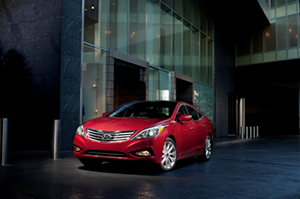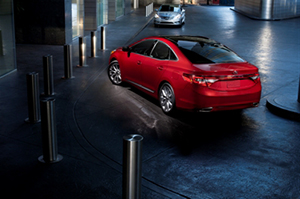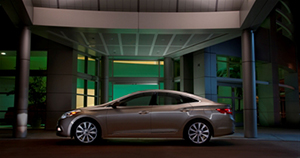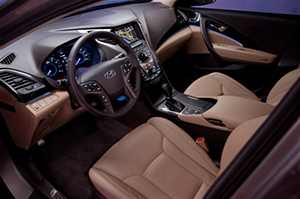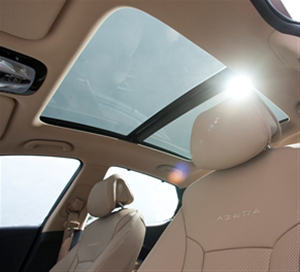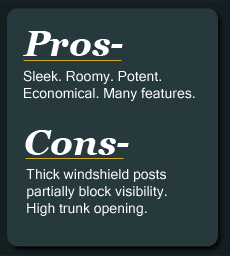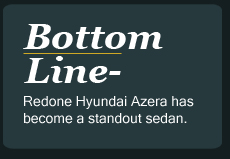2012 Hyundai Azera
Redesigned
2012 Hyundai Azera has swoopy styling. more power, roominess,
economy and upscale features.
Price: $32,000
The old Hyundai Azera sedan was solid, although rather bland. But with
swoopy new styling, more power and lots of features, the redone 2012
model that arrived this spring makes the car really stand out.
The new front-wheel-drive Azera comes in only one spacious trim level
and slots between Hyundai’s Sonata and Genesis models. It
looks more expensive, inside and out, than its $32,000 list price might
suggest. Its nicely shaped and bumper-integrated tailpipes even look as
if they came from a top custom-car operation.
The only option is a $4,000 package that contains such items as wider
tires on 19-inch (vs. 18-inch) wheels, ventilated front seats and a
huge panoramic sunroof with a power sunshade.
The Azera’s long list of standard items include leather
upholstery, push-button start, heated front and rear seats, dual
automatic climate control and a navigation system with a rearview
camera and seven-inch touchscreen. No other car in its market segment
offers manual rear-side-window sunshades.
Safety items include nine standard air bags, including a
driver’s knee air bag, and an alphabet soup of safety items
that include VSM, ESC, TCS, ABS and EBD. Never mind what all that
stands for—Azera buyers only need to know that they help keep
the car safely on roads during trying conditions and give it enhanced
braking.
.The new Azera is powered by a 3.3-liter V-6 with a high-pressure
direct fuel injection system, which significantly increases horsepower
and torque with a sky-high 11.5:1 compression ratio—likely
the envy of 1960s muscle-car fans. The engine generates 293 horsepower
and 255 pound-feet of torque.
The quiet, smooth V-6 has all-aluminum construction, four valves per
cylinder, piston cooling jets and dual continuously variable valve
timing for a broad power spread. A three-stage variable intake system
further broadens the power curve to improve off-the-line acceleration
and passing performance.
Power flows through a six-speed automatic transmission with an easily
used manual-shift feature. My test Azera quickly merged into fast
freeway traffic and delivered brisk 65-80 mph passing times. The 0-60
mph time is 6.7 seconds.
Estimated fuel economy is 20 miles per gallon in the city and 29 on
highways. A driver-activated “Active Eco” mode
modifies engine and transmission control for improved fuel economy that
Hyunda says translates into more than a five percent improvement in
real-world economy.
Helping economy, besides agility and performance, is the solidly built
Azera’s comparatively light weight. It tips the scales at
3,605 pounds, which makes it more than 200 pounds lighter than the
Buick LaCrosse and more than 400 pounds lighter than the Ford Taurus.
The steering feels a little artificial but is nicely geared, at 2.9
turns lock-to-lock. And an all-independent suspension smooths out rough
roads—although serious bumps can be mildly felt.
The Azera is no sports sedan—it isn’t supposed to
be one. But handling is confidence-inspiring. There’s limited
body sway at brisk speeds in decreasing radius turns, such as those on
expressway entry ramps. Brakes are easily modulated.
Big outside door handles and large front and rear door openings make it
easy to quickly enter the Azera, which has a spacious and upscale,
quiet interior. Even the large fold-down rear center armrest, which
contains dual cupholders, looks like it belongs in a more costly car.
Climate and audio system controls are generally easy to use, although I
found the main gauges a little hard to read during the day. And thick
windshield posts partly block driver vision, especially when he is
turning a street corner.
All doors have storage pockets and bottle holders and a deep console
bin with a cover. The Mercedes-style power front seat controls are
handy, and controls for the large outside mirrors are easy to use. But
driver controls for the power windows are set a bit too far back on the
door. At least the windows can be easily stopped at various positions
when moving down or up by tapping a window control.
The large trunk uses shielded hinges instead of struts. It has a wide,
but rather high, opening. And, when the thick rear seatbacks are
flipped forward for more cargo room, the pass-through area
between the trunk and rear seat is only moderately large.
The hood glides open via twin hydraulic struts to reveal a crowded
engine compartment. Still, fluid-filler area are easy to reach from the
front of the car, except for one located behind the engine that must be
reached from the side.
The Azera is another Hyundai winner, delivering more than a buyer would
expect.
